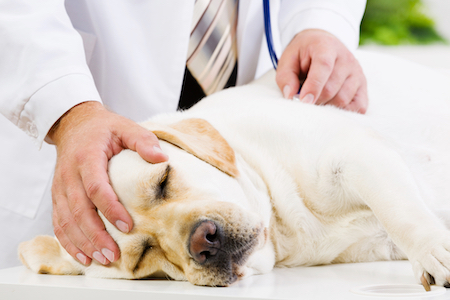Pet Insurance Review > Pet Wellness Guides > Does Spaying and Neutering Your Dog Prevent or Promote Cancer? - Pet Insurance Review
Does Spaying and Neutering Your Dog Prevent or Promote Cancer?
Posted: 11/06/2023 | BY: Erin Cain | Categories: Uncategorized
Did you know that spaying or neutering your dog may prevent some canine cancer? It’s true! Spayed and neutered dogs have a much lower risk of developing cancer in their lifetime. However, recent research has also indicated that a fixed dog may be more susceptible to other forms of cancer or disease due to their breed type. Let’s examine the link between spaying and neutering, cancer prevention, the effects on breeds, and why it is ultimately essential for dog owners to have their pups fixed.

Why spay and neuter?
Spay-neuter has been a relatively routine procedure promoted in the U.S. for pups around six months to a year old. Many veterinarians and animal associations have promoted the benefits of neutering to prevent unwanted puppy litters for decades. Every year, millions of unwanted dogs are euthanized when they could be living happy, healthy lives.
When you have your dog sterilized, it reduces the number of unwanted puppies in communities. Spaying is one way to stop unaltered females from breeding. This procedure helps protect them against serious health problems and reduces many unwanted behaviors associated with the mating instinct. By removing a female dog’s ovaries, she will no longer experience heat cycles and the physical trials that come along with them.
The removal of the testes from male dogs reduces their breeding instinct, making them less inclined to roam. Other frustrating and undesirable behaviors, such as aggressive behavior and behavioral problems, urine marking, digging, and fleeing, also lessen when a male dog is neutered. Additionally, males avoid severe medical diseases and experience medical benefits due to neutering.
While recent studies show that sterilization may negatively impact a dog’s health and wellness, these disadvantages should not outweigh the advantages when considering whether or not your dog needs this operation.

What cancers does spay-neuter reduce?
While there is no way to prevent cancer in dogs, spaying or neutering your dog can reduce their chances of developing certain cancers. Research shows that a spayed female and neutered male reduces these kinds of cancers in dogs:
Mammary tumor or breast cancer
Roughly 50% of canine mammary tumors are malignant. It is one of the most common cancers in unspayed dogs. Hence, an unaltered dog has an increased risk of developing mammary cancer. Depending on the timing of a dog’s spay, that percentage can drop drastically. Female dogs spayed before their first heat cycle have a 0.5% chance of this cancer; after the second heat cycle, that chance rises to 8%; and after a third cycle, the number jumps to 26%.
Spaying female dogs sooner rather than later will significantly reduce her chance of developing breast cancer. Breeds most susceptible to mammary cancer are the Maltese, German shepherd, English setter, miniature and toy Poodle, Boxer, Cocker spaniel, Dachshund, and Yorkshire terrier.
Testicular cancer
Roughly 1 in 3 intact male dogs will develop testicular tumors in their lifetime. An additional 27% of unneutered dogs will also suffer from this particular cancer. Although this cancer is more common in older intact dogs, these malignant tumors can appear in unneutered dogs of any age. When neutering male dogs, a male dog’s testicles are removed; therefore, the risk of testicular cancer development is eradicated.
Uterine and ovary cancer
Although uterine and ovary cancers are less common in unspayed female dogs than mammary tumors, they are in some ways more deadly. This cancer rarely presents any symptoms and is generally found during ovariohysterectomy surgery or autopsy. Chemotherapy treatments typically accompany successful surgeries if cancer has spread before removal. Spaying will remove the possibility of uterine cancer in a female dog.
Ovarian cancer metastasizes and spreads to other organs in the body. By spaying your dog, the ovaries are removed, and so is the chance of your dog having this cancer. This cancer affects some breeds more than others. The most at-risk breeds are the Boxer, Yorkshire terrier, German shepherd, Boston terrier, Poodle, and Pointer dogs.
Are there adverse health effects of spay-neuter?
Veterinarians and researchers are currently examining studies that show a potential for spaying and neutering to lead to some cancer types in dogs. While this information continues to be reviewed, one study has noted how spay-neuter increases the chances of cancer in certain breeds.
Golden Retriever
The study found that nearly 10% of early neutered Golden Retrievers developed lymphoma and had three times more chance of having this cancer than those who are intact. In female Goldens, lymphoma appears more frequently in late-spayed dogs than early-spays. Late-spayed Golden females are also around four times more prone to hemangiosarcoma than unspayed dogs. Mast cell tumors also affect early and late-spayed Goldens and rarely appear in intact females.
Interestingly, the study also found a link between early spaying and early neutering of Golden retrievers and joint disorders, such as elbow dysplasia and hip dysplasia.
Vizsla
Recent studies have found that regardless of age at the time of surgery, the Vizsla is 3.5x more likely to have a mast cell tumor and 4.3x more likely to develop lymphoma. Mast cells affected early-spay or neutered Vizslas, while only spayed females had 9x the chances of hemangiosarcoma than intact females. In general, spayed or neutered Vizslas were 5x more likely to develop other types of cancer than their intact counterparts.
Rottweiler
In male and female Rottweilers who were sterilized before one year of age, there was an increase of three to four times the odds of osteosarcoma (OSA). As OSA in Rottweilers is significantly higher than the rest of the dog population, researchers think there is also a genetic link to blame.
Shih Tzu
Smaller dogs between 20 and 45 pounds are less likely to develop cancer post-sterilization than intact dogs. The only exception is the Shih Tzu. Neutered Shih Tzus have a significantly higher chance of developing other cancers than unaltered canines.
With spay-neuter, the pros outweigh the cons.
So is it still best to spay or neuter your dog? Because these recent studies were limited in scope and number of dogs, more research is needed before saying that spay-neuter is dangerous for dogs. The new data is full of complexities and inconsistencies. For now, the health benefits of spaying and neutering outweigh keeping a dog intact.
It’s also important to note that just because a dog has been spayed or neutered and developed cancer doesn’t mean their lives are shorter. Intact dogs are at higher risk of dying due to trauma and infectious disease related to their intact status. While sterilized dogs may be more likely to develop cancer, they still live longer lives. Some researchers theorize that spayed or neutered dogs are more likely to get cancer because they live long enough to it. Simply put, spaying dogs and neutering dogs leads to longer, healthier lives.
Because all dogs are individual, it’s best to consult with your veterinarian about the best time to spay or neuter your pup.
Let pet insurance can keep your dog healthy.
If your dog develops cancer, diagnosis and treatment will result in costly vet bills for whatever reason. A pet insurance policy can help cover up to 90% of those costs, putting that money back in your pocket so you can focus on what’s most important: your furkid. Get a free quote, and let Pet Insurance Review find the best policy options for you and your dog. Be ready for your dog’s future with pet insurance plan coverage.
Find out what pet insurance covers neutering specifically.
References:
1. Kutzler, M. (2020). Mammary Tumors in Dogs and Cats. Retrieved from
2. Rozenbaum, M. (2020). The benefits and risks of neutering pets. Retrieved from
3. CARE. (n.d.). Effects of Spay/ Neuter on Orthopedic Disease and Cancer in Dogs. Retrieved from
https://caninearthritis.org/article/spay-neuter-orthopedic-disease-cancer/
4. Hohsteter, M., et al. (2014). Canine testicular tumors: two types of seminomas can be differentiated by immunohistochemistry. Retrieved from
https://bmcvetres.biomedcentral.com/articles/10.1186/s12917-014-0169-8
5. Bentley, A., Thalheim, L. (2017). CONTROVERSIES IN SPAYING AND NEUTERING: EFFECTS ON CANCER AND OTHER CONDITIONS. Retrieved from
https://www.cuvs.org/sites/default/files/inline-files/1-4%20Bentley%20Thalheim%20-%20SpayNeuter.pdf
6. Wood, T. (2020). When Should You Neuter Your Dog to Avoid Health Risks? Retrieved from
7. Hekman, J. (2015). Do Spayed and Neutered Dogs Get Cancer More Often? Retrieved from
https://blogs.scientificamerican.com/dog-spies/do-spayed-and-neutered-dogs-get-cancer-more-often/
DisclaimerThe information contained on this blog is intended for informational and educational purposes only and should not be construed as medical advice. It is not a substitute for professional veterinary care. Always consult with your veterinarian before making any changes to your pet's health care or treatment plan.
The authors of this blog are not veterinarians and do not claim to be experts in pet health. The information provided here is based on our own experiences and research, as well as information from reputable sources. However, we cannot guarantee the accuracy or completeness of this information.
We encourage you to do your own research and consult with your veterinarian before making any decisions about your pet's health.